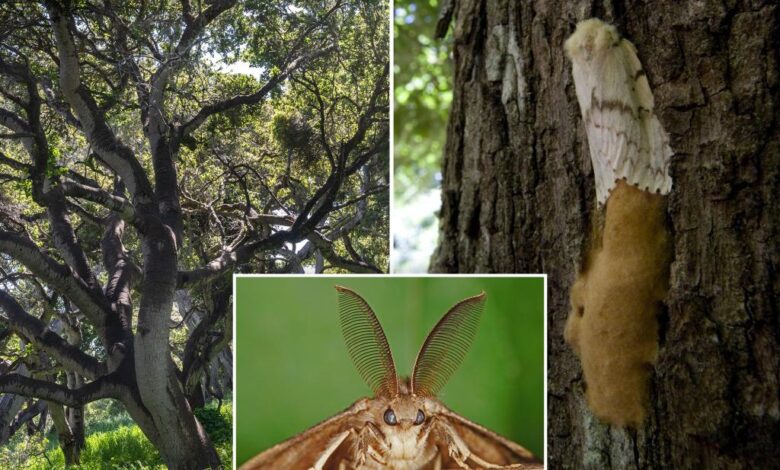‘Gross’ moth invasion wreaks havoc on forests — and property values: ‘A very bad effect’


The butterfly effect has got nothing on moth mayhem.
Thanks to warming temperatures, California could soon be under siege from a “gross” winged terror that decimates trees and could send property values plummeting, per a study published in the journal Nature.
After causing mayhem on the East Coast, the spongy moth has infiltrated parts of Northern and Southern California, where it’s wreaked havoc due to its insatiable appetite — it feeds on over 300 species of plants.
The insect plague “could have a very bad effect” on California’s millions of acres of oak forest, study author Greg Dwyer, who teaches ecology and evolution at the University of Chicago, told SFGate.
The critters devour the trees’ plant leaves, preventing them from photosynthesizing, which can prove deadly if they’re defoliated for several years in a row.
Endemic to Africa and Asia, the spongy moth was first introduced to the U.S. in 1869 by scientist Leopold Trouvelot, who wanted to use them for silk production.
His plan backfired after some of the caterpillars escaped and ballooned across the country via air currents, notably settling in the Northeast, where they come out every spring to consume forests and lay urban foliage bare.
Researchers believe that climate change could be to blame because it hinders one of the ecological terror’s key threats: a fungal pathogen named entomophaga maimaiga.
While the moth-killing mushroom is supremely effective at mitigating the scourge — data from 1996 shows that the fungus helped curb defoliation decline by 85% in multiple states compared to the year prior — it requires cooler temperatures to thrive.
Rising temps have allowed the moths to evade their fungal regulator.
Notably, 16 spongy moths were trapped in the upscale Los Angeles community of Calabasas between October 2023 and July 2024, prompting officials to announce emergency measures to exterminate them.
And while the California Department of Food and Agriculture aims to eliminate them by September 2026, officials say that timeline might have to be extended.
It would be prudent to nip the threat in the bud — past outbreaks in Michigan have resulted in hundreds of square miles of forest being stripped clean.
Along with the notorious lantern fly, the spongy moth is one of the most “economically and environmentally destructive invasive insects,” according to the United States Department of Agriculture, CBS News reported.
The two species are responsible for causing $40 billion in annual damages to crops, trees and other plants, explained Kathryn Bronsky, national policy manager for the spongy moth at the USDA’s Animal and Plant Health Inspection Service.
Forests aren’t the only thing under threat.
This butterfly effect can also torpedo the housing market because “nobody wants to buy a house in an area where the trees don’t have any leaves,” according to Dwyer, adding that they also “leave a terrible mess behind.”
“Their poop is mostly kind of just squishy, cellulose-y kind of stuff, like ground-up celery or something,” said Dwyer. “It’s pretty gross. The insects will be all over the houses and people’s cars and whatnot, so that’s pretty disgusting too, and that reduces property values.”
Unfortunately, exterminating the scourge is no easy feat either, requiring authorities to swaddle trees in burlap to net the larvae, which are then drowned in soapy water or put in a freezer.
Ultimately, without solid natural deterrents like entomophaga maimaiga, keeping the spongy moth at bay could be an uphill battle.
“The thing that always goes through my head is that people think that climate change is just polar bears in the Arctic,” said Dwyer. “But it’s also spongy moths in the backyard of hedge fund managers in Connecticut.”



